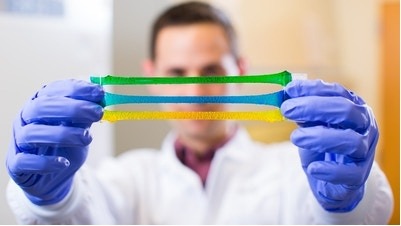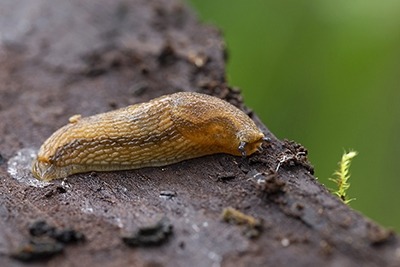Surgical Adhesive Inspired by Slug Slime
An unexpected journey from basic discovery to clinical innovation
From wisdom tooth extraction to open-heart surgery, clinicians rely on stitches and surgical adhesive, or glue, to close and mend our wounds. However, stitches can damage tissue and raise the risk for infection, and surgical glues may be too weak to withstand the body's movements, especially in wet environments like the inside of the mouth. To help patients better heal after injury or surgery, scientists crafted a super-strong surgical adhesive inspired by slime from a common garden critter—the slug.
The medical adhesive—made of gummy-like gel and the slug-inspired glue—is nontoxic to human cells, stretchy like a rubber band, sticky in wet environments, and strong enough to hold on to a beating heart. The adhesive may become a less painful alternative to current wound-closing approaches while promoting healing of human tissues and organs. This versatile material was developed gradually with long-term NIDCR support as an unexpected offshoot of basic research headed by David Mooney, PhD, a bioengineering professor at Harvard University.
"Support for fundamental science helps create a knowledge base that oftentimes ends up being incredibly important in areas we can't even predict," says Mooney. "When we started this work, we certainly had no concept that we were going to come up with a way of making a better medical adhesive for use in the mouth. We were trying to make a better material to regenerate bone."
In his initial proposal to NIDCR in 1998, Mooney set out to develop a material to help reverse oral bone loss by growing bone tissues on artificial scaffolding made of hydrogel, a gelatin-like material composed mainly of water and long molecules called polymers. Along the way, the unique interests of postdoctoral fellows in his lab helped shape the trajectory of research. For instance, according to Mooney, Xuanhe Zhao, PhD, was curious about hydrogel elasticity, and Jianyu Li, PhD, was interested in crafting surgical adhesives. Their projects helped shift the research focus from tissue regeneration to surgical applications.
While studying bone regeneration, Mooney's team observed that the extracellular matrix, a 3-D fibrous network in the body that supports cells, tissues, and organs, is viscoelastic. Materials with this property initially respond elastically to an applied force, but if the force persists, they lose their original shape, like gummy worms and toy slime that stretch and ooze. At the time, Zhao, who is now a professor of mechanical engineering at the Massachusetts Institute of Technology, realized that by mimicking this property, the team could engineer a stronger material that bends but doesn’t break, to improve conventional hydrogels that are weak and brittle.
The scientists weaved an elastic web in the hydrogel with two polymers. Alginate, a sugar that gives seaweed structure and flexibility, allowed the material to stretch and even crack. The other, polyacrylamide, a chemical that offers contact lenses elasticity, served as a tough bridge over the cracks to keep the material from completely breaking. Together, they form a hydrogel that stretches over 20 times its length and is tougher than natural cartilage.
The new material expanded the scope of potential applications for hydrogels, from serving as scaffolds for tissue regeneration to being used as surgical adhesives, a topic that intrigued Li, who joined the lab after Zhao and is now an assistant professor of mechanical engineering at McGill University in Canada.
Existing adhesives often fail in wet or dynamic environments—imagine a bandage that dangles after a shower or one that loosens on a moving elbow. Such adhesives are not suitable for surgical use. But by basing the new adhesive on hydrogel’s unique properties, Li and colleagues solved one of those problems. They found that the gel could hold the glue in place while absorbing the push and pull from body movements without tearing or cracking.
For the adhesive to work on wet surfaces, Li turned to a slimy brown slug, Arion subfuscus, for inspiration. When facing danger, the garden slug oozes a super-sticky slime to glue itself tightly to wet surfaces. The strong adhesion is partly electrostatic, like how a sock clings to a shirt fresh out of the dryer, and partly caused by the slug slime tangling itself with surfaces and binding to them chemically.
“We don’t use any slug components when making the materials,” says Ben Freedman, PhD, a current postdoctoral fellow in Mooney’s lab. “It’s all bioinspiration.” Instead, the scientists based their adhesive on a sugary polymer called chitosan, derived from shrimp shells.
Mooney’s team used animal models to show that the new adhesive—through its combination of tough gel and slug-inspired glue—bends and flexes and conforms to tissues. Scientists tested the adhesive by patching up a damaged heart and repeatedly inflating it. The adhesive withstood thousands of cycles of expansions and contractions, retaining a perfect seal.
Expanding on these findings, the team also engineered a bandage that speeds up healing. The researchers tweaked the gel with polymers that shrink at body temperature and silver nanoparticles to ward off microbes. When applied to mouse skin, the new wound dressing contracted, pulling on the edges of a wound to close it and reduce its size by half within 24 hours. The new approach is over ten times stickier than an adhesive bandage and can heal damaged tissue without scarring.
“It’s important to be able to take research ideas and successfully translate them from bench to bedside,” says Freedman. Besides testing the material for surgical use, Freedman and his colleagues plan to add new functions to the adhesive in the future, including the ability to release drugs and break down naturally in the body.
The tough gel adhesive technology has recently been licensed to a medical device company for exploring its use in oral surgery. With further validation and optimization, the adhesive may one day find use in dental practices as a possible substitute for stitches, or as a wound barrier to protect bone grafts.
“Since the beginning of time, nature has been the world’s most powerful engineer,” says Freedman. "Turning to nature for inspiration often aligns with the engineering principles we've already developed, so we don't always have to reinvent the wheel."
References
Highly stretchable and tough hydrogels. Sun JY, Zhao X, Illeperuma WR, Chaudhuri O, Oh KH, Mooney DJ, Vlassak JJ, Suo Z. Nature. 2012 Sep 6;489(7414):133-6. doi: 10.1038/nature11409.
Tough adhesives for diverse wet surfaces. Li J, Celiz AD, Yang J, Yang Q, Wamala I, Whyte W, Seo BR, Vasilyev NV, Vlassak JJ, Suo Z, Mooney DJ. Science. 2017 Jul 28;357(6349):378-381. doi: 10.1126/science.aah6362. PMID: 28751604; PMCID: PMC5905340.
Bioinspired mechanically active adhesive dressings to accelerate wound closure. Blacklow SO, Li J, Freedman BR, Zeidi M, Chen C, Mooney DJ. Sci Adv. 2019 Jul 24;5(7):eaaw3963. doi: 10.1126/sciadv.aaw3963. PMID: 31355332; PMCID: PMC6656537.
A novel two-component, expandable bioadhesive for exposed defect coverage: Applicability to prenatal procedures. Lazow SP, Labuz DF, Freedman BR, Rock A, Zurakowski D, Mooney DJ, Fauza DO. J Pediatr Surg. 2020 Oct 3:S0022-3468(20)30679-5. doi: 10.1016/j.jpedsurg.2020.09.030. Epub ahead of print. PMID: 33109345.
NIH Support: In addition to NIDCR, support for this research came from the National Institute of Diabetes and Digestive and Kidney Diseases and the National Institute on Aging.
Attention Editors
Reprint this article in your own publication or post to your website. NIDCR News articles are not copyrighted. Please acknowledge NIH's National Institute of Dental and Craniofacial Research as the source.
Subscribe for NIDCR Updates
Receive email updates about the latest advances in dental, oral, and craniofacial research.
November 2024


